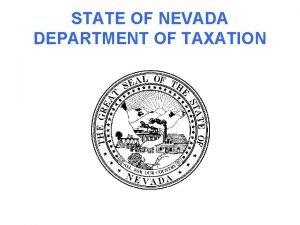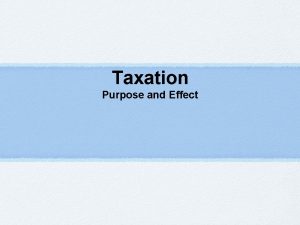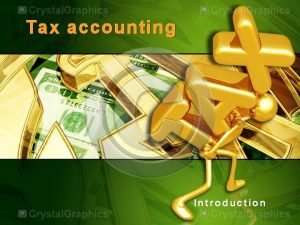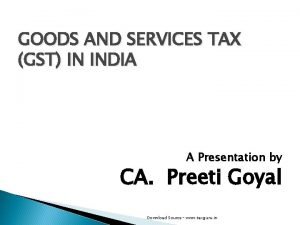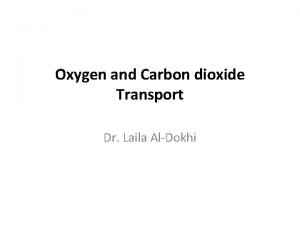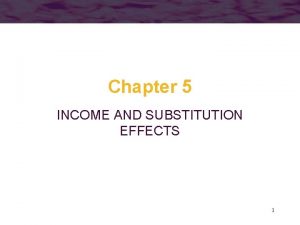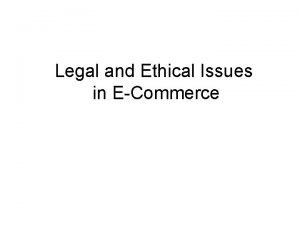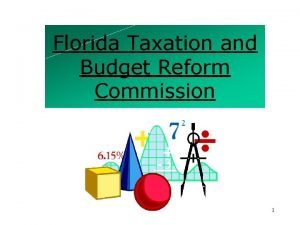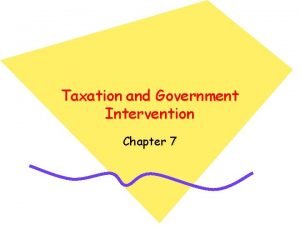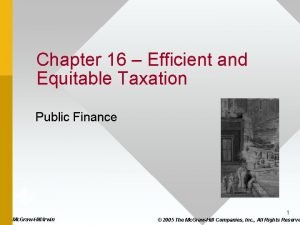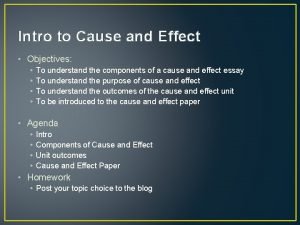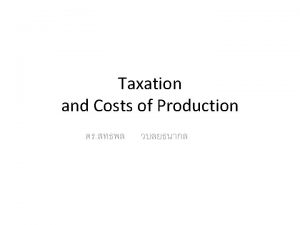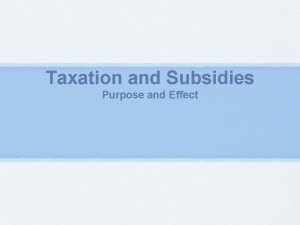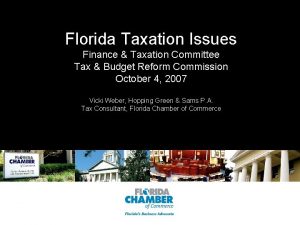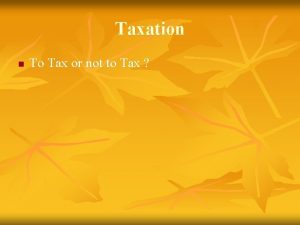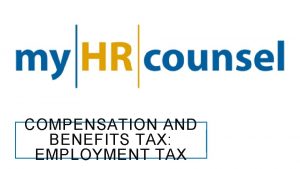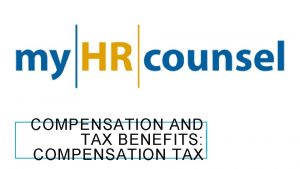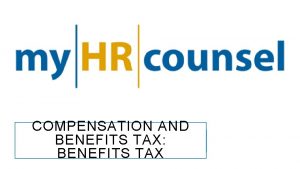Taxation Purpose and Effect Taxation A tax is













- Slides: 13

Taxation Purpose and Effect

Taxation A tax is a government policy that allows the government to obtain a sum of money from consumers or firms for various purposes. 1. For government to obtain funds to run the country or to affect the economy. 2. For government to reduce or curb the consumption or use of an undesirable good (eg. demerit goods like cigarette, alcohol etc) 3. To help government to reduce the income difference by redistributing monies from higher income earners to lower income earners. [demerit good - a good whereby if the government left it to the free market, will be over produced to the extent that it gives of negative externalities and causing markets failure) 4 To curb imports so that the leakage of funds will be reduced so as to achieve a positive and high balance of payment.

Taxation 1. For government to obtain funds to run the country - By using direct tax - eg income tax, tax on property etc. (direct tax meaning the one has to pay the government directly) - By using indirect tax - eg Goods and Service Tax (GST), Electronic Road Pricing (ERP) (indirect tax meaning someone will pay the tax to the government on your behalf eg. the 711 store, petrol station etc.

Taxation P 2. Demerit goods like cigarettes and alcohol affect the environment negatively as well as give rise to social ills. Because of this, the government needs to reduce their consumption through an Indirect tax (eg. GST) How Taxes reduce demand for a demerit good S 1 S 0 Assuming that the initial market equilibrium (E 0) the market clearing price and output is P 0 and Q 0 respectively. E 1 P 1 When an indirect tax is applied (eg. GST), this will increase the cost of production of a firm. (or a producers). As such, owing to the tax, the supply curve will shift leftward from S 0 to S 1 as now less is being produced at every price level owing to the tax. E 0 P 0 D Owing to the tax, the prices will increase from P 0 to P 1 and output will be cut back from Q 0 to Q 1 Q 0 Q With a tax, the government objective of reduction of the demerit good is achieved as its consumption is now decreased from Q 0 to Q 1.

Taxation Amount of GST (an indirect tax) as represented in the diagram. P S 1 S 0 E 1 After the tax is levied, Consumers pay P 1 for a box of cigarettes while Producers receive P 2 for a box of cigarettes P 1 E 1 P 2 Z P 1 E 0 Per unit tax Total Amount of Taxation on the good is = Area P 1 P 2 ZE 1 Z It is equals to P 1 P 2 X Q 1 Consumer portion of tax P 2 D Z Q 1 Producer portion of tax Q 0 Q The total amount of tax is shared and not fully born by buyers. This is called the incidence of tax.

Taxation 3. For the re-distribution of wealth (direct tax eg. Income tax, corporation tax, capital gains tax). - The difference in incomes between the highest earners and lowest earners in a country is called the income gap. - If the income gap is too wide, this means that the rich are getting richer and poor are getting poorer. The governments needs to ensure that the people’s incomes are as equitable as possible so that the poor will not be exploited. - Taxes have the ability to take some from the richer to help supplement the poorer people’s income.

Taxation 4. To reduce imports so as to maintain a positive and stable balance of payment P US, Cellphone Market S - Domestic cellphone too expansive compared to Chinese imported cellphone, P 0<P 1 - Q 1 (quantity demanded) > Q 0 (quantity supplied) (Domestic US Price) P 2 P 0 Import amount before Tariff, T (Import price , China) P 1 D Q 0 Amount of imported Q 1 cellphones Q 1 -Q 0 - Government levies, a tariff (T), to reduce imports Q Import amount after Tariff A tariff can therefore reduce imports and reduce the amount of funds flowing out of a country leading to positive BOP

Taxation Progressive and Regressive Taxation and Ad Valorem Tax How equitable (fair) is taxation? TOTAL SALARY PER YEAR TAX RATE 500, 001 25% 1, 000 1000, 001 20% 500, 000 In the above example, the income tax rate increases with 100, 000 and 10% increasing income/wealth. We call this PROGRESSIVE below taxation. Progressive type of taxation is fair as the wealthier pay more tax.

Taxation Progressive and Regressive Taxation and Ad Valorem Tax How equitable (fair) is taxation? TOTAL SALARY PER YEAR TAX RATE 500, 001 10% 1, 000 1000, 001 10% 500, 000 In the above example, rate is constant at 100, 000 andthe income tax 10% regardless of how much one makes. We call this below REGRESSIVE taxation. This form of tax is not equitable.

Taxation Progressive and Regressive Taxation and Ad Valorem Tax How equitable (fair) is taxation? An ad valorem tax is a tax that is a percentage of the value of the item being taxed. (eg. value of a house, estate tax etc). This form of tax is regressive as the higher the value, the percentage of tax does not increase. (eg. Proportional tax - A tax system that requires the same percentage of income from all taxpayers, regardless of their earnings. A proportional tax applies the same tax rate across. )

Taxation Progressive and Regressive Taxation and Ad Valorem Tax How equitable (fair) is taxation? Question: Which one of the following taxes in Singapore is regressive? Explain your answer: - GST, - Electronic Road Pricing (ERP) - Property Tax, Petrol Tax - Electricity Tax (Tariff) Answer: Except for income tax and electricity, the rest are regressive. This is because the actual amount of tax paid (say $200 of GST, ERP, PT or ET) will affect someone who makes $1000/month more severely than someone who earns $20, 000/month. To the $20, 000 a month person, $200 is nothing while to the other person $200 is a lot.

Taxation Difference between direct and indirect tax 1. Direct tax is (eg income tax) is paid directly to the government while indirect tax is paid via the producer. 2. Direct tax is accrued when you earn someething (eg. Income, inheritance etc). Indirect tax ( eg. GST aka consumption tax) only occurs when you pay or consume something. 3. The amount of the tax can be shifted between producer and consumers. Q: Should Singapore government increase GST and lower income tax in light of the fast aging population? (Hint: Which will give gov more tax revenues? )

P S 0 S 1 P 0 P 1 D Q 0 Q 1 Q
 Nevada department of taxation modified business tax return
Nevada department of taxation modified business tax return Effect of taxation
Effect of taxation Effect of taxation
Effect of taxation What is the purpose of taxation
What is the purpose of taxation Gst conclusion
Gst conclusion Ralphs annual income is about $32 000
Ralphs annual income is about $32 000 Brock corp reports operating expenses
Brock corp reports operating expenses Bohr effect and haldane effect
Bohr effect and haldane effect Substitution effect and income effect
Substitution effect and income effect Ethical issues of e commerce
Ethical issues of e commerce Taxation and budget reform commission
Taxation and budget reform commission Taxation and government intervention
Taxation and government intervention Efficient and equitable taxation
Efficient and equitable taxation Cause and effect purpose
Cause and effect purpose
